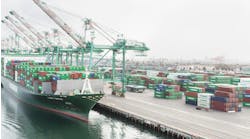Transportation Software Is Crucial for Streamlining Logistics Operations
What you’ll learn:
- Why logistics professionals adopt transportation software
- How trucking software can improve workflows
Trucking software utilization is becoming increasingly popular among logistics leaders who know they must continually reduce inefficiencies, keep costs down and boost productivity wherever possible. Many decision-makers interact with trucking software features as part of larger transportation management systems (TMS). Those platforms assist users with planning, execution and freight-related needs.
Prioritizing Safety with Trucking Software
The most streamlined logistics operations are often the safest ones. Amazon executives adopted that perspective when they implemented various technologies to make the e-commerce brand’s trucks among the world’s most innovative. Leaders partnered with industry stakeholders to install various enhancements on vehicles used for middle and last-mile deliveries. The changes encompassed a $200 million plan to pursue safety upgrades.
For example, the trailers used for middle-mile deliveries have sensors to monitor doors, cargo, braking systems and more. Those upgrades accompany the driver-facing tractor cameras that can identify distracted operators and other risks, which Amazon has used since 2017.
Since appropriate workloads are important for keeping drivers safe, the e-commerce company also invested significantly in its route-planning and predictive analytics software. The associated data feeds into a mobile technology system that Amazon’s carriers and drivers use. Those parties can then access safety tips, real-time alerts, performance summaries and navigation assistance.
These safety improvements also included expanding the number of cameras used within last-mile delivery trucks to identify safety incidents and provide drivers with immediate information about their surroundings. For example, the 360-degree backup detection shows obstacles as drivers reverse their vehicles. Additionally, drivers use routing software that accommodates transportation obstacles such as roadside construction. It also aids vehicle operators in making safer lane changes.
Thanks to the advanced software in Amazon’s fleet, drivers, managers and others can see what happens during every journey. The wealth of associated data allows decision-makers to act quickly and make up-to-the-minute changes in response to fluctuating environmental conditions or other factors that could make deliveries arrive late or result in other unwanted effects.
Satisfying Customers with Speedier Deliveries
The online shopping boom has challenged logistics professionals to be increasingly efficient in delivering parcels to the right places within the expected time frames. Falling short can have costly consequences. A 2024 study showed 45% of customers would be unlikely to make a purchase if the delivery speed was too slow.
Additionally, 14% of deliveries were scheduled to occur within two hours of the order confirmation, but only 26% of brands provided such speed. Similarly, 18% of customers got same-day delivery for their items, but just 34% of brands offered it. These takeaways show that fast deliveries are important for significant percentages of customers, and companies might attract more consumers by handling them.
However, as delivery time frames shorten, logistics professionals must find inefficiencies in their current processes and work diligently to solve them. Trucking software features can help them do so, especially if their chosen platforms have route optimization capabilities. In one case, logistics professionals at a company providing sawn timber for various industries faced challenges because they used a manual route-planning strategy that did not allow for visibility across teams.
Since the logistics network consisted of multiple distribution centers, seven sawmills and hundreds of trucks, decision-makers knew it was time for strategic changes. They achieved them with routing and scheduling software. Managers said the software allowed them to spend significantly less time handling delivery planning and gave them per-depot visibility of what each truck carried. Additionally, people could use the trucking software features to study various loading and delivery scenarios and choose the most appropriate ones. Some vehicles deliver directly to customers, making logistics operations more efficient.
Addressing Maintenance Needs with Trucking Software Features
Truck breakdowns can be prohibitively costly for logistics firms due to the ripple effects they often cause. The associated issues include delivery delays, unplanned costs for urgent repairs and additional risks to drivers if the problems that made their vehicles inoperable are life-threatening.
However, many trucking software providers have addressed that need with specialized products that help users stay on top of maintenance needs and substantially reduce the chances of such incidents. One inspection-based tool generates condition reports in seconds, letting users determine if trucks need servicing to return them to the road. Options also exist that compile sensor data in user-friendly dashboards, showing if specific vehicles suddenly show reduced fuel economy or develop unusual vibrations.
Keeping all the information within a cloud-based platform is an ideal way to improve recordkeeping and eliminate the chances of people losing or damaging physical paperwork. People also do not need to keep track of mileage-based maintenance steps because platforms automatically deliver notifications to users’ phones or inboxes to remind them what to do and when.
Streamlining logistics operations this way allows people to verify how much they typically spend on maintenance needs per month or year. It is then easier to identify abnormalities. For example, if a specific vehicle’s brakes need servicing far more often than its counterparts, that could mean the person operating it needs coaching to reduce the harsh driving activities that result in the brakes not lasting as long as they should.
Remaining Competitive in the Digital Age
Many logistics leaders realize trucking software is essential to help them stay profitable and in demand while retaining current customers and attracting new ones. Making calculations manually is too time-consuming and error-prone, but software fills a well-defined need by helping people work more productively and respond to changing conditions.
Statistics indicate less than 0.3% of carriers have at least 200 trucks in their fleets. That confirms how most operators work outside of the world’s biggest brands, but they still play essential roles in keeping goods flowing through the modern economy.
Anyone who has helped run a smaller business knows it often involves fulfilling many duties, including those not mentioned in official job descriptions. However, trucking software is convenient because it lets people spend more money and time on the specific tasks that directly support their companies’ success.
There is no need to continue using spreadsheets or other inadequate tools to plan routes, schedule loads and ensure that no driver works longer than the legally permissible hours. Research also confirms how logistic professionals increasingly choose digital tools to support their workflows. A 2023 study of global logistics providers and shippers showed that companies utilizing such tools for logistics operations have experienced short-term performance improvements of 10%-20% and enhancements of 20%-40% within 2-4 years.
Start Benefiting from Trucking Software Features Today
Streamlining logistics workflows is an excellent way to impress customers and keep operational costs low. Succeeding can also allow leaders to ensure their offerings are on par with peers. Trucking software can help people achieve many of these goals, strengthening their businesses over the short and long term.









